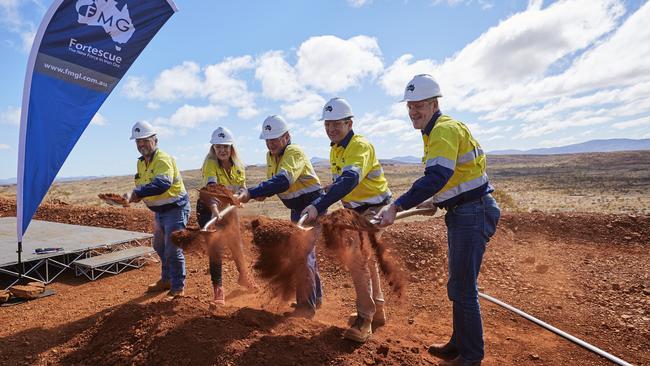Fortescue targets record iron ore output, deepens Chinese base
Fortescue has established an entity in China that will allow it to sell smaller volumes of iron ore to customers, widening its base.

Andrew Forrest’s Fortescue Metals Group has moved to deepen its ties with its Chinese customers amid the first signs that the recent stellar run of iron ore may be starting to run out of puff.
Perth-based Fortescue yesterday announced a strong end to a 2019 financial year that had been wildly profitable for it and its Australian iron ore rivals Rio Tinto and BHP, thanks to a dramatic surge in iron ore prices.
The miner revealed it had shipped a record 46.6 million tonnes of iron ore during the March quarter, helping it make up for some of the output it lost to wet weather earlier this year, and taking total shipments for the 2019 financial year to 167.7 million tonnes. It said it expected to ship between 170 million and 175 million tonnes this year, which, if achieved, would eclipse the 170 million tonnes it shipped back in 2018.
The June output and the sustained rise in iron ore prices suggest Fortescue could post its highest ever profit when it delivers its full-year earnings next month, and paves the way for another big dividend to Mr Forrest and his fellow Fortescue shareholders.
Yet shares in Fortescue and its iron ore rivals have come under pressure in the meantime, amid expectations the booming conditions could soon start to turn.
The surge in the benchmark iron ore prices, from less than $US60 a tonne a year ago to around $US117 today, followed the Brumadinho tailings dam disaster that prompted the shutdown of a large chunk of Brazil’s iron ore miner. But Vale has flagged a partial restart of some of its operations, while steel stockpiles in China have risen during what is typically a time of peak demand.
The shift in sentiment was reflected in a 5.5 per cent fall in Fortescue’s share price yesterday to $8.25. Rio Tinto also suffered a 4.2 per cent fall, to $96.29, while BHP fell 1.8 per cent to $40.59.
Fortescue chief executive Elizabeth Gaines acknowledged the rise in Chinese steel inventories but said demand for the company’s products remained strong.
“With steel inventories, there has been some unseasonal increase. Some of that is the heavy rain we’ve seen in southern China. There are a range of factors that can influence the market, we do stay very focused on the things we can control and importantly we do stay close to the market,” she said.
Fortescue revealed it had established an entity in China that would allow it to sell smaller volumes of iron ore to customers. The new office, which will also accept payment in renminbi rather than US dollars, is part of Fortescue’s efforts to broaden its customer base.
“We’ve been working on this for some time,” Ms Gaines said. “The reason we did it is very strategic, it’s really to access segments of the market that weren’t previously available. It’s really been driven by that customer demand, particularly around regional customers who may not have access to the seaborne market.”
Fortescue has benefited in the past year not only from a rise in the benchmark iron ore price, but also a fall in the discount it receives for its lower grade ore. The average price it received in 2019 jumped 50 per cent to $US65 a tonne.
Ms Gaines declined to elaborate on recent reports linking Fortescue to iron ore mining and infrastructure opportunities in Liberia and West Africa.
“We don’t comment on specific opportunities, but we do have a very active business development team and they are focused on growing our business and diversification,” she said.
The strong iron ore prices of the past few months helped lift Fortescue’s cash on hand from $US1.1 billion at the end of March to $US1.9bn by the end of June, even after the company spent $US314m on sustaining capital, exploration and development and $1.8bn on a 60c a share special dividend.
The company was tight-lipped about what to expect when it announces its latest dividend this month.

